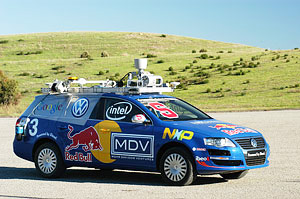 The DARPA Grand Challenge is one of the most unusual car races in the world. In this race, the cars drive themselves - no remote controls needed. And the contest is not a game. It could change the way all of us drive. We visited the leading Bay Area team, the Stanford Racing Team, as they geared up for this year’s race.
The DARPA Grand Challenge is one of the most unusual car races in the world. In this race, the cars drive themselves - no remote controls needed. And the contest is not a game. It could change the way all of us drive. We visited the leading Bay Area team, the Stanford Racing Team, as they geared up for this year’s race.
The race is sponsored by the Department of Defense's research division, known as DARPA. Their goal is to convert one-third of their ground vehicles to unmanned vehicles. That's where the contest comes in-- to develop the technology needed for such an application. Early uses could be surveillance on the ground or convoy missions, but they haven't ruled anything out. What are your thoughts on the wartime purpose of this contest?
The Stanford team, like many others, see this technology being used far and wide in the future. The laser sensors that the robots use are much more accurate than human eyes. So, robotic cars could follow each other very closely, which could have major impacts on traffic and the need for new roads. Autonomous vehicles could help elderly and disabled drivers, too. It sounds like science fiction, but scientists are on their way. Would you use a robotic car?
UPDATE: The Stanford Team's car, Junior, took second place in the race this past weekend. I've heard it was a very close race with six team completing the whole course. Check out the full race results or read a San Francisco Chronicle article on the finals.
![]() You may listen to the "Robot Car Race" Radio report online, as well as find more resources. Also, don't miss our behind-the-scenes photos for this story on flickr.com.
You may listen to the "Robot Car Race" Radio report online, as well as find more resources. Also, don't miss our behind-the-scenes photos for this story on flickr.com.
